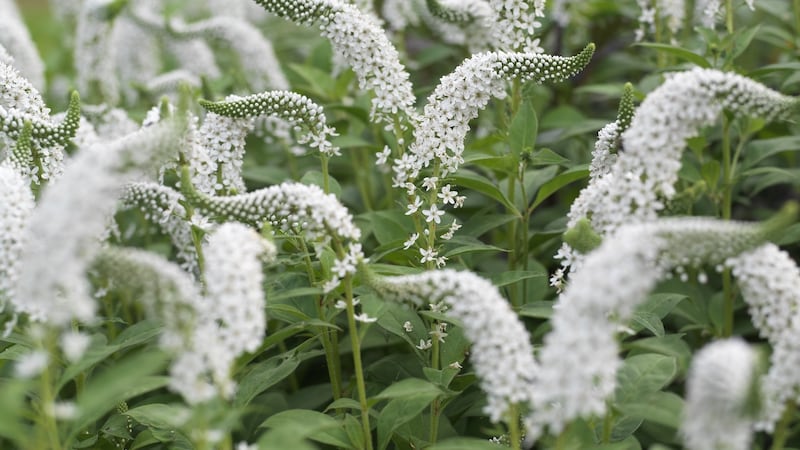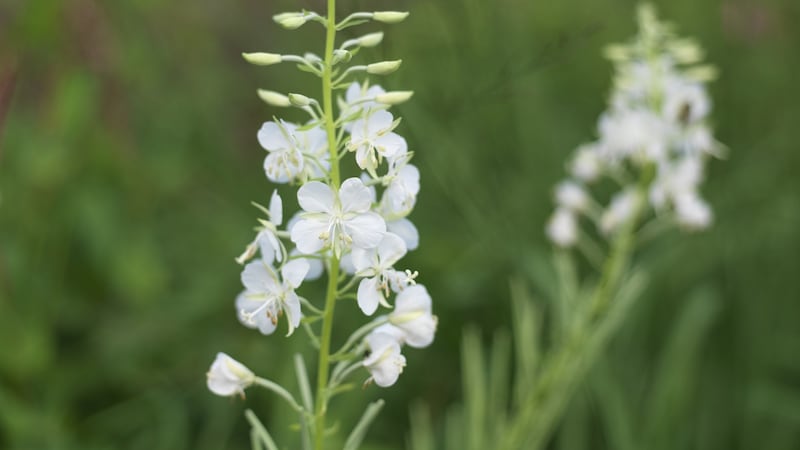Most keen gardeners can rattle off a list of the popular hardy perennials that act as the colourful mainstays of the late summer garden.
Well-known examples include yarrow (achillea), sneezeweed (helenium), crocosmia, agapanthus. hardy geraniums, sedums, rudbeckias, penstemons, verbenas, double dahlias and asters.
But did you know that there’s a host of other, lesser-known, late-flowering perennial species that can be used to add colour, texture, structure and that all important sparkle to your garden and prevent it from sliding into the dreaded autumn doldrums while also providing lots of nectar and pollen for bees, butterflies and other pollinators? Read on . . .
Commonly known as Culver’s root, the tall, elegant flower spires of Veronicastrum virginicum appear from late summer to autumn and are both beautiful and bee-friendly; in fact all pollinating insects find its nectar and pollen-rich blooms utterly irresistible.
Reaching an average height and spread of 150 x 50-60cm and happy in sun or light shade and in average soil as long as it’s not too dry, this hardy perennial is great for adding dramatic structure, form and colour to the garden at this time of year. Of the many varieties available, look out for V. ‘Fascination (pale lavender); ‘Adoration (lilac-pink); ‘Apollo’ (lilac-blue); ‘Pink Glow (silver-pink); and ‘Diane’ (white).

Its common name ‘gooseneck loosestrife’ is a reference to the way the pretty, snow-white flower spikes of Lysimachia clethroides gently curl at one end. Hardy, floriferous, happy in sun or light shade and a moist but free-draining soil, this clump-forming, rabbit-resistant, easy-to-grow herbaceous perennial reaches an average height and spread of 90cm x 60cm. An extra plus is the showy display of autumn colour as its leaves turn bright scarlet before the plant dies back down to the ground for the winter.
Commonly known as toadflax, perennial types of linaria produce lots of tall, airy, ultra-delicate flower spikes that are perfect for weaving lacy, almost transparent webs of colour through a summer/autumn border as exemplified in the remarkable gardens of Hunting Brook in west Wicklow.
Bees and other pollinating insects also adore the slender flower spires of this ultra-long-flowering perennial, which needs full sun and a free-draining soil.
In particular look out for Linaria ‘Peachy’ (soft peach-and-yellow, a nearly sterile variety that’s exceptionally long-flowering), Linaria ‘Dial Park’ (dusty-pink) and L. ‘Tarte au Citron’ (creamy lemon-rose pink-peach, also almost sterile and exceptionally long-flowering). Average eight and spread 90-120cm x 60cm.
Powerful whiff
Ornamental alliums are typically associated with early summer but some species of this genus of bulbous perennials make a wonderful contribution to the late summer/autumn garden. Chief amongst them is Allium sphaerocephalon, whose long-lasting, green-and-claret-coloured, egg-shaped flowers appear on tall, slender stems from late July-early September.
Best grown in a fertile, free-draining soil, it looks wonderful sprinkled through a sunny border where it will often naturalise and also makes an excellent, long-lasting cut-flower. Height 90cm
Commonly known as Mexican giant hyssop or Korean mint, the aromatic foliage of agastache (pronounced a-gah-sta-kee) emits a powerful whiff of liquorice when bruised while its strongly vertical, decorative flower spikes are beloved of bees and other pollinators.

Best in full sun and a well drained, fertile soil, many varieties are only borderline hardy, making them suitable only for more sheltered gardens but Agastache ‘Blue Boa’ has proved its toughness by enduring temperatures as low as -5C. Producing its plump, violet-blue flower spikes from mid-summer to the first harsh frosts of autumn, this compact variety reaches a height and spread of just 25cm x 30cm. Other recommended varieties include A. ‘Blue Fortune’ (blue flowers, 90cm x 75cm) and Agastache rugosa f. albiflora (white, 90cm x 75cm).
The tall, muddy-pink flower spikes of the native perennial wildflower known as rosebay willowherb (Chamerion angustifolium), are a common sight around the countryside at this time of year, appearing en-masse along roadsides, woodlands, damp meadows and boglands.
While the wild plant is known for its invasive qualities, the lovely white-flowered form (Chamerion angustifolium ‘Album’ ) is an altogether more refined variety easily controlled in a garden setting. In bloom from July until October, it grows happily in sun or shade and reaches an average height and spread of 1.5m x 50cm.

Artemisia lactiflora (white mugwort) is another elegant star of the late summer/autumn border with an airy growth habit and tall, graceful, pollinator-friendly sprays of silver/white flowers (July-September) that resemble those of astilbe.
Happy in sun or light shade and in a rich, moist but free-draining soil, it’s also deer- and rabbit resistant. Recommended varieties include the purple-stemmed A. ‘Guizhou’ group and A. ‘Elfinbein’ (height and spread of 1.2m-1.5m x 75cm)
Numerous spikes
Imagine a daintier, more compact yet even more floriferous version of catmint and you have Calamintha nepeta ‘Blue Cloud’.
Best in full sun and a free-draining soil, this dainty but hardy perennial is commonly known as lesser calamint and forms neat, low clumps of aromatic grey-green foliage covered with spikes of tiny, silver-blue flowers from July- late September. The white flowering form, Calamintha nepeta ‘Alba’ is equally lovely. Height and spread of 75cm.

Persicaria amplexicaulis (bistort) is another long-flowering hero of the summer/autumn border, an ultra-hardy, floriferous, easy-to-grow perennial that produces numerous spikes of pollinator-friendly, colourful flowers for months on end.
Best grown in a moist but free-draining soil in full sun/ light shade, many excellent varieties are available including P. ‘Fat Domino (deep red flowers, height and spread of 1.2m x 75cm); and P ‘Alba’ (white flowers, height and spread of 90cm)
Traditional double-flowered dahlias (flowers with many petals) have become one of the classic ingredients of the late summer/autumn border. As extravagantly beautiful as they are, they don’t have the grace and pollinator power of the single-flowered species-types, which combine elegant growing habits with long, slender stems and an ultra floriferous habit. Surprisingly difficult to source as plants, these are easily grown from seed (stockists include juneblake.ie) sown in spring under cover with heat.
(Recommended stockists include mountvenusnursery.com, camolinpottingshed.com, juneblake.ie , huntingbrook.com and good Irish garden centres)
This Week in the Garden
Container displays of summer bedding often begin to falter at this time of year for various reasons including inconsistent watering, a shortage of nutrients and/or a failure to regularly deadhead plants.
To revive them, soak the pots/troughs/ hanging baskets in a wheelbarrow, bath or barrel filled with diluted seaweed/ tomato feed for a few hours. Follow this by cutting away any faded flowers/half-formed seedheads and dead/damaged/ discoloured leaves. Plants in very poor shape should be gently removed and replaced.

Many garden centres offer discounted bedding plants at this time of year but make sure to choose only those that look healthy, happy and well-cared for and to soak their rootballs in water before planting. To keep bedding displays looking great until the first hard frosts, keep them regularly watered (hanging baskets in particular need watering at least once a day) and deadheaded, and liquid feed them every 7-10 days.
Get ahead of the crowd and enjoy the best pickings by placing your spring flowering bulbs order now. Many of the choicest/ must-have varieties go out of stock by early autumn as do the larger/better quality bulbs.
Recommended online stockists include mrmiddleton.com, peternyssen.com, avonbulbs.com and sarahraven.com Bear in mind that ParcelMotel is a great way to organise speedy, cost-effective delivery from suppliers outside Ireland
Visit this
Killruddery House & Gardens in Bray east Wicklow, is one of Ireland's oldest gardens. Under the loving stewardship of its owners, the Ardee family, it's becoming known not only for its atmospheric gardens but also for its fantastic weekly farmers market (every Saturday 10am-3pm), new farm shop (Wednesday-Saturday 10am-5pm) and garden coffee shop supplied with free-range eggs, fresh organic produce and cut flowers from its wonderful walled garden.
There’s also plenty for children to enjoy including craft workshops, picnic spaces and the ‘Squirrel’s Scramble’ tree adventure park, see killruddery.com
Read this
'A Lesson in Art & Life: The Colourful World of Cedric Morris and Arthur Lett Haines' by Hugh St. Clair (Pimpernel Press, £30) a biography of the colourful, glamorous lives of the 20th-century artist and award-winning British plantsman Cedric Morris (celebrated for his work as breeder of the so-called Benton irises) and his partner Arthur Lett Haines (a talented artist and cook who was greatly admired by the food writer Elizabeth David).
Dates for your Diary
Tomorrow, Sunday August 4th (10am-5pm), Farmleigh, Phoenix Park, Dublin, Farmleigh Autumn Plant Fair & Farmer's Market including stalls by many of the country's leading specialist plant nurseries, admission free, see farmleigh.ie; Also Sunday 4th (2pm), 'Patthana Gardens, Kiltegan, County Wicklow, 'Using Colour in the Garden' a talk by owner TJ Maher, gardens also open to public every Sunday until October 1st.
Continuing until Monday August 5th, Carlow Garden Festival, see carlowgardenfestival.com; From now until August 25th, June Blake’s Garden, Tinode, Blessington, County Wicklow, ‘A Month of Dahlias’ with free garden tour every Sunday (2pm), see juneblake.ie.

Until August 12th, National Botanic Gardens, Glasnevin, 'For the Love of Trees', an exhibition of paintings of trees growing in Kilmacurragh gardens by the artist and designer Bill Fallover, see botanicgardens.ie.
Saturday August 10th (11am-4pm), Plant Fair at the Irish National Stud and Gardens, Kildare in association with Irish Specialist Nursery Association with guest speaker/ demonstrator and bonsai specialist Ian Young of NI Bonsai Society, see irishnationalstud.ie













